

 Kentucky's tobacco growers now have multiple, foliar
fungicide options in their disease-control tool box,
although the number available is still low. Foliar applied
products can be important tools for controlling diseases,
especially blue mold, in the tobacco field when used
correctly.
Kentucky's tobacco growers now have multiple, foliar
fungicide options in their disease-control tool box,
although the number available is still low. Foliar applied
products can be important tools for controlling diseases,
especially blue mold, in the tobacco field when used
correctly.
Using the correct chemical, the proper rate, the appropriate application method, and at the correct timing are important to successful use of foliar-applied controls. Essentially all those currently labeled on tobacco will perform best when used prior to infection (in a preventive role) rather than waiting until the disease is damaging the crop, yet certain of these chemicals also have some rescue potential. For most, thorough coverage is critical to success, especially under strong disease pressure. Consequently, a good sprayer specially equipped to deliver foliar protectant-type fungicides in a tall, dense, row-crop is needed. In fact, the failure to adopt proper spray equipment is the leading reason for lack of success with foliar fungicides in tobacco. Actigard 50 WG is the only material listed here that can be used successfully with limited coverage of the tissues you desire to protect!
The Kentucky Blue Mold Warning System should be a excellent tool to assist growers in the need and timing of foliar fungicides in tobacco. That website is located at: http://www.uky.edu/Agriculture/kpn/kyblue/kyblue.htm
The chemical options listed below have proved effective in our experiments and demonstration trials and were labeled for the uses mentioned as of April 15, 2002. There may be others that are labeled for tobacco, but are not included here, because they have not proven to be effective under Kentucky's disease conditions, or in valid efficacy tests conducted by pathologists in other major tobacco production areas. Also, not included are chemicals which are reportedly being used and may even have proven efficacy, but they are not labeled for field-tobacco-use in Kentucky, including: Aliette, Bayleton, Benlate, Bleach, Captan, Flint, Nova, Quadris, Rovral, and Tilt. Tobacco marketing laws directly prohibit the marketing of tobacco treated with unlabeled chemicals. Therefore, the use of these unlabeled materials should be discouraged at all levels of the tobacco industry.
ACTIGARD 50WG has a federal label supporting use in blue mold control on both burley and dark tobaccos as a broadcast, foliar spray at 0.5 oz/acre, using 20-30 gallons of water per acre. The preharvest interval is 21 days and the re-entry interval is 12 hours. Application cannot begin until after the plants reach a height of 18" (stalk length from bud to the soil line) due to serious phytotoxicity problems. A second application can be made 10 days later.
The active ingredient (acibenzolar-S-methyl or benzothiadiazole) is not directly toxic to the target pathogens. Instead, it is a plant defense activator that induces (triggers) a series of natural chemical reactions in the treated plant that activate the plant's own resistance mechanisms - called the SAR (systemic activated resistance, also called systemic acquired resistance). Consequently, disease control is normally not obtained until four or five days after the application is made and there may be other desirable and undesirable physiological changes that occur under certain conditions in the treated plant. The rate needs to be calculated carefully, as high rates can be very phytotoxic and lower rates greatly reduce efficacy. Yellowing of the foliage occurs during the time defense chemicals are present, but this yellowing and the control dissipate with time. It is important to control blue mold prior to the plants reaching the stage that Actigard can be used, as well as, in late-maturing varieties, by using additional fungicides when blue mold favorable periods exist. Follow directions carefully, in order to achieve the desired disease control without causing crop damage. Application rate and timing are critical to achieving control while minimizing the phytotoxicity. The label clearly states these "do nots" and I urge growers to follow label warnings:
ACROBAT MZ is labeled under a state label (24c) until December 31, 2002. It is not anticipated that this state label will be renewed after this season, now that national labels are present on other products. It contains two fungicidal chemicals - the systemic dimethomorph and the protectant mancozeb. Acrobat MZ is labeled only as a foliar spray to be applied at 2.5 lbs/100 gallons/acre (volume adjusted for stage of growth). It is highly effective when applied well and at close intervals, even under aggressive disease pressure, but of limited value when applied poorly or the intervals are not maintained. Application can be made on a 5-7 day spray schedule, once advisories have been issued, but applications should be discontinued when and if the threat of blue mold subsides. Sprays should be applied in a preventive manner by ground-operated, high-pressure sprayers equipped with hollow-coned nozzles on drops, or with mist blowers or other air-blast equipment. Up to 8 applications can be made per crop, but the limit is 10.0 lbs/field/season, and with no more than 2.5 lbs/acre per application. The preharvest- interval is 30 days between last application and harvest. When being used in a weekly spray schedule, this fungicide will also provide significant control of frogeye leaf spot, brown spot and ragged leaf spot, but it is not specifically labeled for these. However, the greatest pressure for these diseases is after topping, so in reality, Acrobat MZ provides limited protection against these late season leaf spots. Also, it has not proven effective in the control of target spot in the field.
ACROBAT 50 WP (containing only the systemic compound dimethomorph as an active fungicide) now has a national label for use in a tank-mixture with other fungicides labeled for being delivered as a foliar spray to prevent infection and reduce the spread of blue mold in tobacco fields. Because thorough coverage is critical to control and resistance management, use is allowed only with tractor-driven, air-blast, or mist blower sprayers, while use in hand-pump and other low-pressure sprayers is prohibited. Use of Acrobat 50 WP alone is prohibited. Use in all transplant production systems and the transplant water are also prohibited. The rate of Acrobat 50 WP is 7 oz/100 gallons of water, using 20 gallons of this solution when the plants are small increasing the volume as the plants grow. The label has good directions for the mixing rates at various stages of growth. For aerial applications, use 8 oz of product per acre, in at least 15 gallons of water per acre, regardless of the stage of the crop. Do not exceed 32 oz/acre total for the season. The preharvest interval is O days for Acrobat 50 WP, but the mixing partners all have much longer intervals, so in reality the preharvest interval is 21-30 days for burley and dark tobaccos.
DITHANE DF RAINSHIELD was recently labeled under a state label, 24-c for use in the field. This special state label for the field was needed mainly to have a mixing partner for use with Acrobat 50 WP. Dithane DF applications need to be made as with Acrobat MZ but the rate is 1.5-2.0 lbs/100 gallons of water in weekly foliar sprays for blue mold prevention. To be effective, the fungicide mixture must be applied to achieve complete coverage of the plant's foliage. Sprays should be discontinued when the threat of blue mold no longer exists. This spray program will also assist in early season control of frogeye, brown spot and ragged leaf spot, but not target spot. The preharvest interval between last application and harvest is 30 days.
STREPTOMYCIN 17-21% [sold as Agri-Mycin 17, Agri- Strep 21, and others] @ 0.5 to 1.0 lbs/ 100 gallons of water is labeled for control of angular leaf spot and wildfire under a national label. Rarely is this material needed in the field, but if serious levels of angular leaf spot persist, then control can be achieved in most cases with streptomycin, if it is applied with a good sprayer. It has some systemic activity, but good coverage of at least one side of the leaf is important. If the disease is active at the time of the application, make the first spray at 1.0 lbs/ 100 gallons (200 ppm) then shift to lower rates until control has been achieved. These sprays may be repeated at 5 to 7 day intervals. For best results, make these applications late in the day or at night. Streptomycin is also labeled for control of blue mold, but we have had limited success in the lab and field against current isolates of blue mold using Streptomycin. Because bacterial diseases normally develop under very wet conditions in rapidly growing tobacco, having soil conditions to support spray equipment is often the limiting factor unless sod drive- strips are present.

 We have received several reports of serious wireworm
activity in corn this spring. Last year, we also had an
increased number of wireworm reports in some central
Kentucky corn fields. There are several species of
wireworms that attack corn seed and seedlings. Some of
these species have life cycles that extend over three to
five years, which would mean that a particular field
with a problem one year may have a problem with
wireworms the following year as well. Generally, corn
following grass or legume-grass sod are at greater risk
due to wireworms, but they can also be a problem in
continuous row cropping of weedy fields.
We have received several reports of serious wireworm
activity in corn this spring. Last year, we also had an
increased number of wireworm reports in some central
Kentucky corn fields. There are several species of
wireworms that attack corn seed and seedlings. Some of
these species have life cycles that extend over three to
five years, which would mean that a particular field
with a problem one year may have a problem with
wireworms the following year as well. Generally, corn
following grass or legume-grass sod are at greater risk
due to wireworms, but they can also be a problem in
continuous row cropping of weedy fields.
Unlike some other corn insect pests, wireworms when present are in the field prior to planting. As weeds are controlled during corn planting, they move to feed on the germinating seeds. Growers then notice inconsistent stands once the corn emerges due to the destroyed seeds. Seedlings that do emerge can be fed on by the wireworms for several weeks before the plants out grow these potential problems. Wireworms can bore into the base of the young seedlings. A deadheart is caused as they feed on the growing point and the youngest leaf pushing through the whorl is killed.
Once symptoms of wireworm damage become visible,
there are no rescue treatments that are effective.
Controls for wireworms are preventive, they must be
applied by planting. Currently, seed treatments,
preplant incorporated applications of liquid
formulations, and soil insecticides applied at planting
are recommended for wireworm control.
For more information about corn pests, visit "Insect Management Recommendations".

Dr. Jimmy Henning, UK Extension Forage Agronomist, is reporting that symptoms typical of spring black stem disease of alfalfa are common in many areas. Spring black stem is very common in Kentucky, and the wet weather that prevailed in late March undoubtedly provided a sustained infection period that led to the current situation. Look for dark brown to black lesions on the stem that can be several inches long, and coalesce to cover most of the stem when severe. Infections can also occur on leaflets. Typically these appear as small dark brown to black spots; just a few of these can cause the leaflets to turn yellow and fall off.
If the disease continues to develop, cut and bale the growth early if possible. Even if you normally wait until early flowering, a severe outbreak of spring black stem can justify cutting during the bud stage. By leaving the crop in place, it will continue to defoliate (costing a producer loss in yield and in forage quality). By cutting early, producers will capture whatever yield in available, and it will allow sunlight and wind movement to penetrate to the new crown buds that will break dormancy when the disease gets severe enough.
The UK recommendation is to cut alfalfa when it is ready, not to wait for a forecast of 3-4 days of sunny, dry conditions. Advancing maturity causes substantial loss of forage quality anyway, and this would only be made worse if spring black stem is active. Thus, waiting for dry weather can cost as much or more than rain damage to the hay.
See Insect Recommendations for more alfalfa pest recommendations.

 I do not want to raise undue alarm, but I thought it
prudent to alert you about a significant wheat stripe rust
epidemic which is now occurring in parts of Arkansas.
I am most concerned about what is happening in
northeast Arkansas. Dr. Rick Cartwright, the Arkansas
Wheat Extension Plant Pathologist, has indicated in the
newsletter "Wheat Pest Bytes" that stripe rust is
extremely active in northeast Arkansas, as well as other
areas of the state. This development could be an
important player in Kentucky over the next 2 weeks or
so.
I do not want to raise undue alarm, but I thought it
prudent to alert you about a significant wheat stripe rust
epidemic which is now occurring in parts of Arkansas.
I am most concerned about what is happening in
northeast Arkansas. Dr. Rick Cartwright, the Arkansas
Wheat Extension Plant Pathologist, has indicated in the
newsletter "Wheat Pest Bytes" that stripe rust is
extremely active in northeast Arkansas, as well as other
areas of the state. This development could be an
important player in Kentucky over the next 2 weeks or
so.
Stripe rust epidemics, as with all rust epidemics in wheat, can be very fast moving. I have seen pictures from Arkansas where entire fields are yellow in appearance by the boot stage of crop development, due to stripe rust infection. I have not seen this before with stripe rust, but I have seen similar situations in 1985 in Kentucky with leaf rust. When stripe rust is this severe, even a casual observation of affected plants will reveal masses of bright yellow-orange rust pustules in diseased leaves. These pustules are in rows that follow leaf veins. Observations in Arkansas and the literature on the disease indicate that the stripe rust pathogen is active as long as nighttime temperatures stay below 70 F. This temperature limitation is not much of a factor in Kentucky, since 70 F nighttime temperatures will probably not be reached and sustained until sometime in June. Infection requires periods of free moisture on leaves, moderate temperatures, the presence of stripe rust spores and a susceptible wheat host.
Observations in Arkansas indicate that the following soft red winter wheat varieties are highly susceptible to the strain of the stripe rust fungus now active in Arkansas: Pioneer 26R38, Pioneer 2684, Agripro Mallard, and AgriPro Shelby. NK 9663, AGS 2000, and DK 1551W appear to be moderately susceptible. The least affected varieties at this time are AgriPro Patton, AgriPro Shiloh, Pioneer 26R24, Pioneer 2580, Delta King 9121, Delta King 9027, Delta King 9416, Armor 3135, Armor 4045, Terral TV 8555 and Sabbe.
Stipe rust can be effectively controlled using foliar fungicides. The most rust-active fungicides available in Kentucky are Quadis (Syngenta) and Stratego (Bayer). Tilt and PropiMax (i.e., propiconazole) are also highly effective, but the period of effectiveness is not as long as with Quadis and Stratego. Quadris is expensive, but can be applied up to crop flowering in Kentucky. Stratego is similar in cost to Tilt and PropiMax, but it cannot be applied once the flag leaves have emerged. Tilt and PropiMax have the same time of application restriction as Stratego in Kentucky. Thus, if stripe or leaf rust, or any foliar fungal pathogen for that matter, begin to threaten wheat beyond the flag leaf stage, only Quadris may be applied legally.
If you begin to notice that even minor levels of stripe or leaf rust are developing in a crop with an excellent yield potential, up to crop flowering, it may be a good idea to apply a fungicide. But, if you should decide to take that route, do not hesitate and delay the application for very long. As I indicated, rust diseases, including stripe rust, can blow into and "blow up" a good looking crop in a relatively short period of time (10-14 days). It is always best to scout your fields before making any fungicide use decision. Wheat profitability is already limited, so the last thing anyone needs to do is to apply a fungicide (or any pesticide) unless indications are clear one is needed.
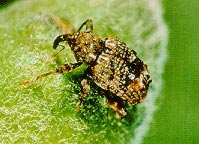 As usual we have been having another unusual spring
with respect to the weather conditions. In the past, one
indication of when plum curculio activity would begin
was when the nighttime low temperatures first exceeded
60F. In an average year, this first occurs in the spring
sometime between the petal fall and first cover stages of
apple development. This is one to three weeks after
bloom. These warm nighttime temperatures seem to
trigger the return movement of the plum curculio back
into apple orchards.
As usual we have been having another unusual spring
with respect to the weather conditions. In the past, one
indication of when plum curculio activity would begin
was when the nighttime low temperatures first exceeded
60F. In an average year, this first occurs in the spring
sometime between the petal fall and first cover stages of
apple development. This is one to three weeks after
bloom. These warm nighttime temperatures seem to
trigger the return movement of the plum curculio back
into apple orchards.
This year, we experienced nighttime low temperatures above 60F prior to apple bloom. How will this affect plum curculio movement? We are not sure, but there are several factors to consider. First, plum curculio is not able to do any damage until the petal fall stage, so there is no reason to spray an insecticide until we reach petal fall. In order to protect insect pollinators, we must avoid all insecticide applications while trees are still in bloom. Much of the plum curculio damage occurring right at the petal fall stage will drop from the tree, as most blossoms do not become apples.
What can we expect with plum curculio? If the warm temperatures continue after petal fall, the we would expect plum curculio to be an early threat. Commercial apple growers would be advised to apply a spray for plum curculio at the petal fall stage, and if plum curculio activity continues, then a second spray at first cover may also be needed.
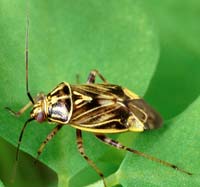 The tarnished plant bug causes damage to strawberries
by destroying the seeds on young fruits before
receptacles expand. These damaged areas do not
develop along with the rest of the berry, resulting in
misshapen "catfaced" fruit. Adults are recognized by
their greenish-brown body marked with yellowish and
black dashes with a characteristic small yellow-tipped
triangle behind the head. Adults become active in April
and begin egg laying in weeds. The tiny nymphs are
slender, pale green insects that resemble long-legged
aphids. However, aphids have a pair of cornicles (tail
pipe-like tubes on top of their abdomen)and tarnished
plant bugs do not.
The tarnished plant bug causes damage to strawberries
by destroying the seeds on young fruits before
receptacles expand. These damaged areas do not
develop along with the rest of the berry, resulting in
misshapen "catfaced" fruit. Adults are recognized by
their greenish-brown body marked with yellowish and
black dashes with a characteristic small yellow-tipped
triangle behind the head. Adults become active in April
and begin egg laying in weeds. The tiny nymphs are
slender, pale green insects that resemble long-legged
aphids. However, aphids have a pair of cornicles (tail
pipe-like tubes on top of their abdomen)and tarnished
plant bugs do not.
Most damage to strawberries takes place just after petal fall. Early June bearing varieties can escape most tarnished plant bug injury because pest populations are small and consist of less damaging, younger plant bugs. However, late maturing cultivars are more susceptible to damage. Plantings near alfalfa fields, woods, or weedy areas are more prone to damage. Alternative hosts, especially weeds and seed-producing plants should be eliminated around the strawberry plantings. Regular mowing or weeding may help, but should be avoided just before or during the blossom period. From pre-blossom until harvest, shake blossom or fruit clusters from ten to fifteen plants per acre over a light colored pan. Treatment for plant bugs is suggested when levels reach an average of 0.5 nymphs per cluster.
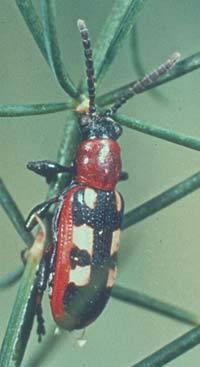 As the new asparagus shoots begin to emerge,
commercial growers and home gardeners should be
watching to asparagus beetles. There are two species of
asparagus beetles, but the common asparagus beetle is
the most common in Kentucky. This quarter-inch beetle
has black wing covers with three white spots and a red
thorax. Adults of the common asparagus beetle emerge
early in the season to feed on spears and ferns. Adult
feeding disfigures the spears, rendering them
unmarketable. Eggs are laid in rows on the spears also
makes them unmarketable. Larvae emerging from the
eggs are dark and slug-like. The larvae feed on
developing ferns and defoliation ferns can occur if large
populations are left unchecked. Commercial producers
can use Ambush, Lorsban, Pounce or Sevin to control
asparagus beetles, while home gardeners can get
excellent control of the adults and larvae with Sevin.
As the new asparagus shoots begin to emerge,
commercial growers and home gardeners should be
watching to asparagus beetles. There are two species of
asparagus beetles, but the common asparagus beetle is
the most common in Kentucky. This quarter-inch beetle
has black wing covers with three white spots and a red
thorax. Adults of the common asparagus beetle emerge
early in the season to feed on spears and ferns. Adult
feeding disfigures the spears, rendering them
unmarketable. Eggs are laid in rows on the spears also
makes them unmarketable. Larvae emerging from the
eggs are dark and slug-like. The larvae feed on
developing ferns and defoliation ferns can occur if large
populations are left unchecked. Commercial producers
can use Ambush, Lorsban, Pounce or Sevin to control
asparagus beetles, while home gardeners can get
excellent control of the adults and larvae with Sevin.
Warm temperatures are triggering the emergence of several key horticultural pests. If control is warranted, the time for action is now when pest life stages are most vulnerable. These timely recommendations have been made possible by the phenological management schedule developed by the UK Horticultural Entomology Research Lab. A copy of the table can be found in extension publication ENT-66, Timing Control Actions for Landscape Insect Pests.
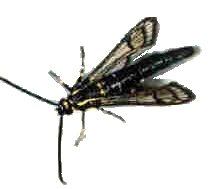 Lilac borer/Lesser peachtree borer- Adults of both
species are, or soon, will be laying eggs on the bark of
susceptible plants. Principal hosts for lilac borer include
lilac, ash and privet; for lesser peachtree borer, peach,
plum, and flowering cherry. Wood borers are among the
most destructive and difficult to control pests of
landscape plants. The larvae tunnel and feed under the
bark of trees and shrubs, destroying water and
sap-conducting tissues. This causes a loss of vigor and
overall weakening that can eventually kill the tree.
Infestation sites also provide entry points for disease
organisms. Symptoms include dieback, cankers or
cracked bark, and accumulations of sawdust-like frass
on the bark or at the base of the tree.
Lilac borer/Lesser peachtree borer- Adults of both
species are, or soon, will be laying eggs on the bark of
susceptible plants. Principal hosts for lilac borer include
lilac, ash and privet; for lesser peachtree borer, peach,
plum, and flowering cherry. Wood borers are among the
most destructive and difficult to control pests of
landscape plants. The larvae tunnel and feed under the
bark of trees and shrubs, destroying water and
sap-conducting tissues. This causes a loss of vigor and
overall weakening that can eventually kill the tree.
Infestation sites also provide entry points for disease
organisms. Symptoms include dieback, cankers or
cracked bark, and accumulations of sawdust-like frass
on the bark or at the base of the tree.
Controlling borers is difficult because there is only a narrow window of opportunity for treatment. Eggs are laid on the bark of preferred hosts, and within 1 to 2 weeks the young borer larvae emerge and quickly tunnel inward. Once inside the tree, the larvae are protected from insecticide sprays. Therefore the key to control is having a lethal residue of insecticide on the bark to intercept newly-hatched borers before they burrow into the tree. Lindane and chlorpyrifos (Dursban) have been the 'standards' for borer control, but both products are becoming harder to find. Permethrin (Astro) may also be effective. The trunk and major limbs of susceptible trees should be sprayed to runoff as specified on the label.
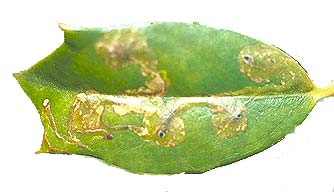 Holly Leafminer- Adult holly leafminers are beginning
to fly and lay eggs in newly-expanding holly leaves.
The small, pin prick feeding punctures and oviposition
scars of the tiny adult flies do not harm the tree, but
subsequent mining by the larvae is cosmetically
unappealing. Control of the egg laying adults can be
accomplished by applying insecticides such as Orthene,
Sevin, Talstar or Tempo, just as the newly expanding
leaves are unfurling. Control of larvae already in the
leaves (mid- to late May) can be attempted with one of
the systemic materials, e.g., Cygon, Dimethoate, or Di-
Syston. Blue holly is relatively resistant to leafminer
injury.
Holly Leafminer- Adult holly leafminers are beginning
to fly and lay eggs in newly-expanding holly leaves.
The small, pin prick feeding punctures and oviposition
scars of the tiny adult flies do not harm the tree, but
subsequent mining by the larvae is cosmetically
unappealing. Control of the egg laying adults can be
accomplished by applying insecticides such as Orthene,
Sevin, Talstar or Tempo, just as the newly expanding
leaves are unfurling. Control of larvae already in the
leaves (mid- to late May) can be attempted with one of
the systemic materials, e.g., Cygon, Dimethoate, or Di-
Syston. Blue holly is relatively resistant to leafminer
injury.
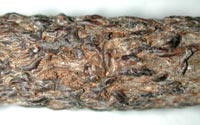 Oystershell Scale - The vulnerable "crawler stage" of
the oystershell scale has begun to hatch. Susceptible
hosts include lilac, willow, maple, ash, apple, dogwood
and others. Infested limbs and twigs are encrusted with
1/8-inch long curved scales that resemble miniature
oystershells. Crawlers are susceptible to sprays of 2%
horticultural oil, insecticidal soap, Tempo, Scimitar,
malathion, and a variety of other conventional
insecticides. .
Oystershell Scale - The vulnerable "crawler stage" of
the oystershell scale has begun to hatch. Susceptible
hosts include lilac, willow, maple, ash, apple, dogwood
and others. Infested limbs and twigs are encrusted with
1/8-inch long curved scales that resemble miniature
oystershells. Crawlers are susceptible to sprays of 2%
horticultural oil, insecticidal soap, Tempo, Scimitar,
malathion, and a variety of other conventional
insecticides. .
There are several diseases of trees, shrubs, and fruits in the landscape that are already showing symptoms. Symptoms of other diseases are likely to appear soon. Weather has played a role in providing conditions conducive for disease. The past two weeks have been abnormally warm. Extensive wet periods occurred the last weekend in March just as new foliage was appearing on many plants. Significant wetness also appeared the second weekend in April and again last weekend. The following observations have been made:
--Apple scab lesions were visible and sporulating last week ( April 19) on some susceptible flowering crabapples. Primary scab infections very likely occurred on leaf tissue just emerging from the buds the last weekend in March (March 29-31). Although temperatures were fairly cool, the length of time leaves were wet was long enough for infections to occur. Most apples are not yet showing scab symptoms because they were mostly still in the bud in March and probably did not become infected.
--By this past weekend (April 20), apples were in full bloom and many crabapples were still in bloom. Extended warm weather this past 2 weeks (April 8- 20) followed by rain this past weekend provided excellent conditions for primary fire blight infections. We should see the results of these infections in the coming weeks. Some areas received hail yesterday (April 21) which could increase the severity of fire blight.
--Powdery mildew was active on the shoots and new foliage of susceptible flowering crabapples this past week. In addition to the familiar white fungal signs, symptoms of leaf stretching and distortion were also visible.
--On eastern red cedars, cedar-apple, cedar-hawthorn, and cedar quince rust diseases were all active during wet periods this past weekend. The orange, gelatinous spore-producing structures released spores to nearby crabapples, apples, and hawthorns where symptoms of leaf, stem, and fruit infections will appear next month.
--Kabatina blight symptoms recently appeared as brown, dead shoot tips on junipers.
--Heterosporium leaf spot is already active on some iris plants.
--Shade tree anthracnose disease symptoms are not yet widespread, but recent rains should increase anthracnose activity.
--Backyard grapes have grown several inches this season and have been exposed to weather conditions conducive for black rot disease. Symptoms will appear in the coming weeks.

 Many clients having been calling about the large, black
bees hovering around eaves, decks, and wood siding of
their homes and outbuildings. These are probably
carpenter bees searching for mates and nesting sites.
Carpenter bees cause cosmetic and structural damage to
wood. They can also be quite intimidating and have the
potential to inflict painful stings.
Many clients having been calling about the large, black
bees hovering around eaves, decks, and wood siding of
their homes and outbuildings. These are probably
carpenter bees searching for mates and nesting sites.
Carpenter bees cause cosmetic and structural damage to
wood. They can also be quite intimidating and have the
potential to inflict painful stings.
The Problem- Carpenter bees are similar in appearance to bumble bees, but have different nesting habits. Bumblebees generally nest in the ground, whereas carpenter bees tunnel into wood to lay their eggs. Bare, unpainted, weathered softwoods are preferred, especially redwood, cedar, cypress and pine. Painted or pressure-treated wood is much less susceptible to attack. Common nesting sites include eaves, fascia boards, siding, wooden shake roofs, decks and outdoor furniture.
Carpenter bees overwinter as adults in old nest tunnels. After mating, the fertilized females excavate galleries in wood, laying their eggs within a series of small cells. The cells are provisioned with a ball of pollen on which the larvae feed, emerging as adults in late summer. The entrance hole and tunnels are perfectly round and about the diameter of your finger. Coarse sawdust, the color of fresh cut wood, is often seen beneath the entry hole, and burrowing sounds may be heard within the wood. Female carpenter bees may excavate new tunnels or enlarge and reuse old ones. Serious damage can result when the same piece of wood is worked year after year.
Males are often aggressive, hovering in front of people who are around the nests. The males are harmless, however, since they lack stingers. Female carpenter bees can inflict a painful sting, but seldom will unless handled or molested.
The Solution- The best time to control carpenter bees is before tunnels are fully excavated. For homeowners, liquid sprays of Sevin or a pyrethroid (e.g., Bayer Advanced Home/Lawn & Garden Insect Killer, Spectracide Bug Stop, Ortho Home Defense System) can be applied directly into nest openings, or broadcast sprayed as a deterrent onto wood surfaces attracting large numbers of bees. (The broadcast spray approach is often warranted when carpenter bees are riddling siding on a barn, wood shake roofs, or similar large expanses of wood.) Residual effectiveness of such applications is only about 7-14 days, so the treatment may need to be repeated. Tunnels that have already been excavated can also be treated with an insecticide dust (e.g., Sevin), 'puffed' into the nest opening. Wasp and hornet aerosol sprays are also effective and generally more convenient than dusts for treating individual galleries. Although carpenter bees are less aggressive than wasps, female bees provisioning their nests will sting. Treatment is best performed at night or while wearing protective clothing.
Leave the holes open for a few days after treatment to allow the bees to contact and distribute the insecticide throughout the nest galleries. Then plug the entrance hole with a piece of wooden dowel coated with carpenter's glue, wood putty, or other suitable sealant. This will protect against future use of the old tunnels, as well as moisture intrusion and wood decay.
Carpenter bees normally will not tunnel into painted wood. Therefore, a more permanent solution is to paint unfinished wood surfaces, especially those with a history of being attacked. Wood stains and preservatives are less reliable than painting, but may provide some degree of repellence versus bare wood. To further discourage nesting, garages and outbuildings should be kept closed when carpenter bees are actively searching for nesting sites. The annoying flying/nesting habit usually subsides by late May.
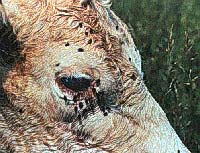 Horn flies and face flies breed in cattle droppings in
pastures. This is a weak link in the life cycle of these
pests because the maggots are concentrated in the
manure before they emerge as adults and attack
animals. Manure piles are scattered over pastures;
elimination of them or treatment of individual piles is
impractical. However, manure can be made toxic if the
animals consume an oral larvicide.
Horn flies and face flies breed in cattle droppings in
pastures. This is a weak link in the life cycle of these
pests because the maggots are concentrated in the
manure before they emerge as adults and attack
animals. Manure piles are scattered over pastures;
elimination of them or treatment of individual piles is
impractical. However, manure can be made toxic if the
animals consume an oral larvicide.
Mineral blocks or loose supplements are available which contain either the organophosphate insecticide or an insect growth regulator. Organophosphate insecticides work upon the nervous system of an insect, killing it quickly. An insect growth regulator interferes with the development of the insect, specifically the molting process. Maggots generally survive but fail to become normal adults. The action of the maggots still contributes to the physical breakdown of the manure. Feed-thrus are only a part of a total pasture fly control program because horn flies and face flies will move in from nearby herds. Supplemental control though the use of dust bags or backrubbers is needed to deal with these "fly-ins".
For more information about livestock pests, visit
"Insect Management Recommendations".

Sluggo (1% iron phosphate) granular bait has been registered to protect various vegetables, berries, fruit, outdoor ornamentals, and lawns from slug and snail damage. The product is registered for greenhouse uses, also. (Monterey Lawn and Garden Products, Inc. Fresno, CA.)
Frankfort, KY - Like mosquitoes and dandelions, vendors selling bogus home and garden chemicals have reappeared with the coming of spring in Kentucky, the state Department of Agriculture has reported.
The Department's Division of Pesticide Regulation is receiving an increasing number of complaints from consumers that people are selling them ineffective chemicals over the phone, Agriculture Commissioner Billy Ray Smith said.
"These vendors make deceptive claims about their products and offer them for more than they are worth," Commissioner Smith said. "Consumers need to understand that, if something looks too good to be true, it usually is."
"The people selling these products often claim that they will kill whatever pest you may have, no matter what it is," explained John McCauley, director of the Division of Pesticide Regulation. "They also will say their product will kill the pest without affecting whatever you may want to save. Either of these claims should be red flags for consumers that they may not be getting what they're paying for."
The KDA's Ken Franks said consumers should ask questions and take good notes when being solicited to buy home and garden chemicals. Consumers should try to find out:
To register a complaint or check to see whether a product is registered for use in Kentucky, contact Ken Franks by telephone at (502) 564-7274 or by e-mail at ken.franks@kyagr.com.

Samples diagnosed in the PDDL during the past week have included Sclerotinia crown and stem rot on alfalfa; Pythium root rot on tobacco (including some severe cases); Pythium root rot on lettuce (greenhouse); Heterosporium leaf spot on iris; tip blight (Sphaeropsis) and tip moth on pine; Volutella blight on boxwood; and cold injury on maple.

UKREC-Princeton, KY, Apr 12 - 19| Black Cutworm
| 1
| True Armyworm
| 48
| | |
NOTE: Trade names are used to simplify the information presented in this newsletter. No endorsement by the Cooperative Extension Service is intended, nor is criticism implied of similar products that are not named.
Lee Townsend
Extension Entomologist